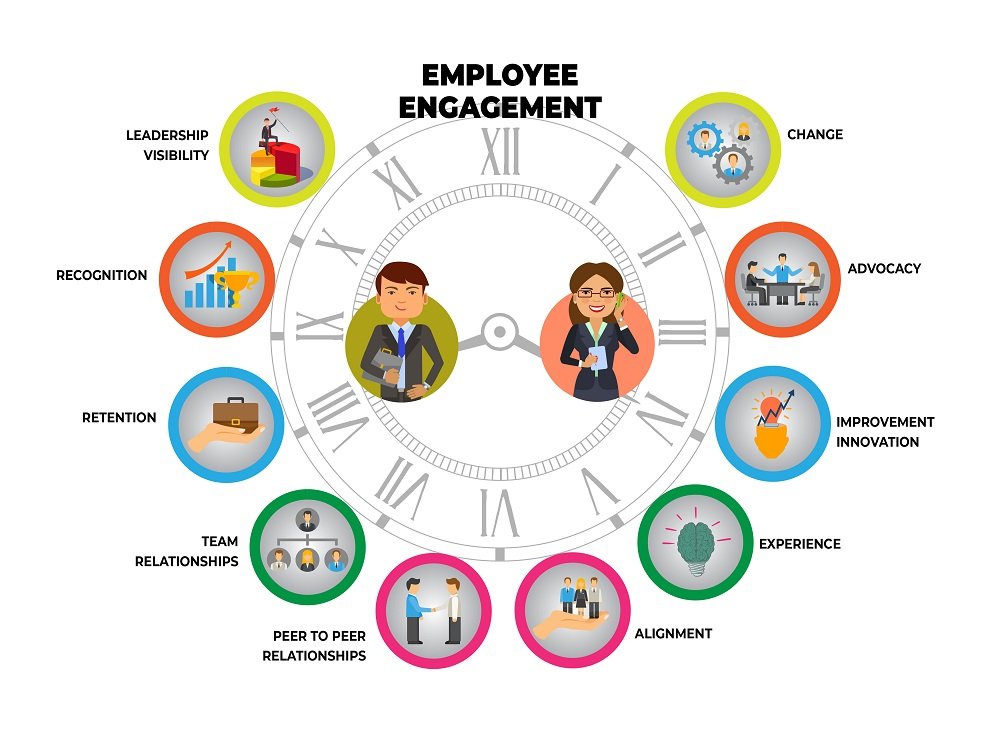Employee engagement is one of the key elements of creating a successful business. However getting employee engagement is not easy to achieve. Recent studies show that only 15% of employees are engaged in their work. This points out some serious problems in the modern workplace
Before we delve into the recent workplace statistics, let us take a look at what employee engagement or worker engagement is.

Employee engagement
In today’s world, getting new talent is a very challenging task. New studies reveal that 63.3 % of companies state, it is more difficult to retain employees than to hire them.
The word “war for talent” is getting very common in today’s world due to lack of talents. Businesses cannot find people with the right skills to fill their expectations and keeping the top talents is also very difficult.
Do you know that more than 1/3rd of workers today are casually or actively looking for a job. Also both companies and employers spend more than $2.9M per day looking for new talent?
How can you retain new talent?

The most effective way to retain new talent is by increasing employee engagement. Employee engagement can be defined as the emotional connection an employee has for their company. This is important because when an employee feels aligned with the goals of a company, they will work harder for said goal.
Employee engagement ensures maximum performance. However, it not about giving people bonuses and benefits.
Here are some reasons why it is important to have employee engagement:
Employee engagement increases productivity and studies show that companies with a higher employee engagement are 21% more profitable. Employee engagement also improves the morale of the team. Studies show that employees who show high engagement report 41% lesser absenteeism.
Employed engagement is also crucial to your customer service as well. Research shows that having low employee engagement will be costly for the company since it takes around $4,219 to hire a new employee.
Therefore, employee engagement is crucial for any organization.
Here are some important employee engagement statistics that you should know.
Important Employee Engagement Statistics You Need to Know in 2021

There are many employee statistics out there but not all of them are relevant for you. So we have compiled a list of the important employee engagement statistics.
85% of Employees Are Not Engaged in the Workplace
In the State of the Global Workplace study by Gallup it is shown that only 15% of employees are engaged in the workplace. This implies that the majority of the employees are not working at their full potential and are likely doing the bare minimum to get through the day, since they have no emotional attachment.
Around 81% of Employees Consider Leaving Their Jobs
According to a study, 81 percent of employees are considering leaving their current jobs, even if they are not actively looking for one. For 74 percent of employees, a pay cut for their ideal job is a welcomed idea. While 23 percent states that they need no pay increase for a new position.
Having a good employee relationship is important for retaining them. Additionally their work life and personal life should have a balance.
Due to Low Employee Engagement Companies spend $450-500 Billion Each Year
New studies show that employee disengagement costs a company around $450-550 billion per year. The same disengaged workers also show very poor attitudes and temperament at the office and reduce office morale.
Companies that have Highly Engaged Workforce Are 21% More Profitable

Employee engagement is not just about improving the morale of workers it also has substantial benefits in the workplace. Employee engagement is an effective business strategy. In Gallup’s meta-analysis it showed that the work units and the businesses that have high employee engagement have at least a 21 percent increase in profitability.
Also, a 17 percent increase in productivity was shown in companies where there was high employee engagement. Companies ensure successful employee engagement by making sure that all the employees have the right tools and knowledge available to perform their jobs as well as possible.
Good communication also leads to more productive employees.
A recent Interact/Harris Poll shows that 91% of the surveyed employees stated that their leader lacked the necessary communication skills.
1 in 3 Professionals state Boredom as Their Main Reason to Leave Their Current Jobs
At least 33 percent of employees stated that boredom was the reason why they left their current job.
The other common reason was that they felt that the company didn’t resound with their values. 24% of people cited this as their needs, and therefore, improving the personality of the employees is very important.
When asked about the most important thing for improving performance, at least 37 of the employees cited recognition as the most important factor.
Only 29% of employees are truly satisfied with their jobs and are happy with the advancement of their careers according to studies.
Has COVID-19 affected Employee Engagement?
The impact of the pandemic has been devastating for many. Since they had to adapt to a new method of working and that too happened very rapidly and very quickly.
Digital Internal Communication

The pandemic quickly killed the outdated traditional communication system. As companies had to adopt to a new method of communication, and the ideal candidate was digital communication.
Digital communication is easy, fast, and develops a sense of belonging within the employees of the company, their wide reach also makes it popular among the employees.
Employee wellbeing is now prioritized
A new worker engagement trend seen in 2021 was that employers were more empathetic to their employees. The pandemic and the toll it has had on the mental health of the employees is another reason for this huge positive change.
It has also been proven that this empathetic and caring approach is more effective and efficient, and has a more positive impact on an employees feelings towards their company or workplace.
Employee feedback is important
Although the traditional structures have provided feedback, recent employee engagement surveys show that it is a crucial part of the checklist of all the employers.
By looking at some studies, we can see that how the pandemic has affected the workplace
- 88% of organizations have helped their employees to adapt to the new structure.
- While 60% of employers have tried to hear more from their employees
- Only 47% of employers have ensured that there was a system to provide security to their employees.
- Some studies show that at least 73% of the respondents believed that work from home has helped them improve their efficiency.
- 22% of remote employees stated that it was hard to unwind after work
- A full week of virtual meetings made at least 38% of employees feeling stressed while 30% felt exhausted
- After the pandemic’s inception, 75% of employees say they feel more socially isolated, 57% expressed greater anxiety, and 53% say they are emotionally exhausted.